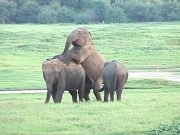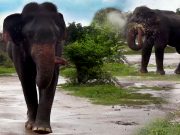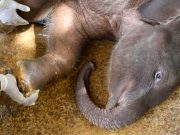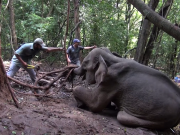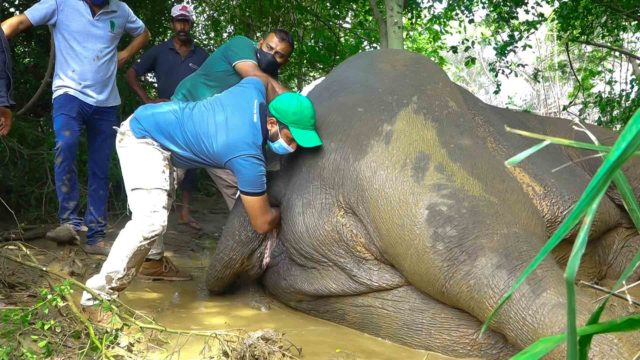Always keep in mind that sick elephant will not return to normal if it does not get correct treatment , even if the medicines are there.
If an elephant is so sick that it cannot rise on its own, the wildlife officers should consult with a veterinarian about how to arrange the position that the elephant has assumed so that it represents the least danger.
The largest part of an elephant’s life is eating, followed by drinking and sleeping. Therefore, a review of the animal’s recent eating, drinking, and sleeping in the 3-5 days
Feeding: If the elephant has been eating food that is difficult to digest, for example very long-fibered food (such as lianas, banana tree stalks, or palm fronds) that has not been cut to suitable lengths, the elephant can become constipated. Or if the elephant has been eating foods that can cause gas, such as maize [corn] or unhusked rice or wheat or cassava, the elephant can have dyspepsia. These conditions can cause an elephant to die in one to three days.
By the way when we talk about the this elephant ,he is getting sick by eating polythene . His stomach is full of polythene .The polythene fluid in the abdomen should be removed.
Elephants consuming polythene as a result of garbage collecting in and surrounding forest reserves due to poor waste management in many districts has been a long-term issue concerning the safety of wildlife in Sri Lanka. The
main pathology caused by ingestion of polythene is due to their retention and obstruction of the alimentary tract. the majority of the dung of elephants feeding at the dump to contain plastics.
you can see that Elephants have very strong muscles especially the leg muscles that must support such great weight. The legs must bear a weight of about 2 000-3 000 kilograms in the case of mature elephants. The front legs bear two out of three parts of the weight.
The feet and legs are like those of the hippopotamus and tapir with the front legs longer than the back. Weight is distributed on a foot pad. The elephant has only one gait, the walk, so, unlike a horse, it can neither trot or gallop. Still, using the walking footfall pattern, elephants can “run” [technically, amble] quite quickly. The world record was set by a Thai elephant electronically measured at 23.84 kph. In a working day, a mature elephant can safely transport goods or people over level ground for 25 kilometres. Traversing hills, that distance should not exceed 15 kilometres. (Wild elephants on average cover only 4 kilometres a day.)
Muscle strains are found mostly in elephants that are at very hard work or are put to unusual work or are fed an unbalanced diet.
Giving injections is supposed to be done only by veterinarians, because it can be dangerous if the proper method is not used.
You can see how the fluid is removed through the rectum.
The elephant should be made to lie on one side or the other. A sick elephant should never under any circumstance be allowed to lie couched on its belly because it will be unable to breathe properly and can even suffocate because of pressure placed on the lungs.
With sick elephants that are resting on their sides, the side should be changed at least twice a day to prevent a build-up of blood on one side [hypostatic congestion].
If an elephant is on the ground for over one week, bed sores [pressure wounds or sores] are likely to develop.Good bedding material, such as dried grass or straw, helps prevent pressure sores.
The elephant is thin, swollen with fluid under the jaws, listless, has little strength, and the skin is hard and wrinkled.
So ,These Asian elephants can easily be domesticated. They have lived together with humans for centuries and are a part of this island country’s religious culture. And do you know elephant has a kid’s mind. So love them , protect them and focus that inocent soul . So join us to do that .








